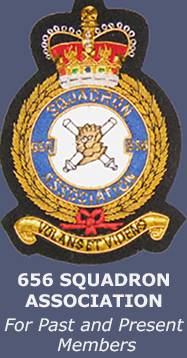Malaya – Korea 1948-1960
Terrorist Threat in Malaya 2. Move to Hong Kong 3. Korea 4. Malaya Part II 5. 1955 6. 150,000 Flight Hours
Back in Kuala Kumpur, Malaya
By the middle of December the Squadron was once again concentrated at Kuala Lumpur, where in its absence, on 01 April 1946, the BMA had been dissolved and replaced with a confederation named the Malayan Union, the first governor of which was Sir Edward Gent. It was regarded by the Colonial Office in Whitehall as a first step towards independence, but was unpopular in Malaya, as it had been imposed without sufficient local consultation.
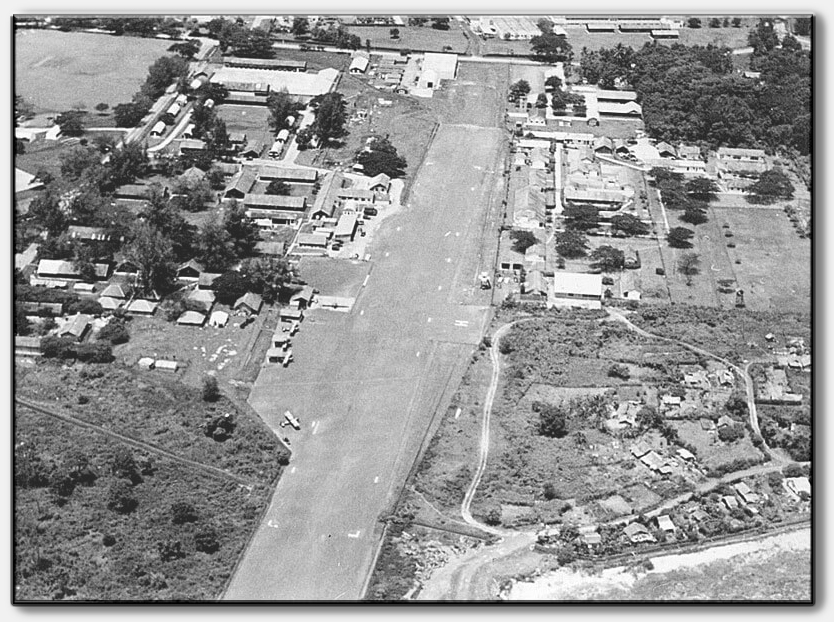
Noble Field, Kuala Lumpa
Singapore was separated from the confederation and made a Crown Colony in its own right, with its own governor – the aim being to preserve its status as a developing free port, air and naval base, while also marginalizing the impact of Singapore’s one million ethnic Chinese on Malayan politics as a whole.
The Squadron Disbanded
The New Year, 1947, was to bring a very significant change as, on 15 January, the Squadron was disbanded, with the exception of one flight, which became No 1914 (AOP) Flight, remaining at Kuala Lumpur under the command of Captain Russell Matthews, MC. Many of the officers and men returned to the UK and the majority of the Auster IVs and Vs were sold to local scrap dealers – a sad end after such loyal and groundbreaking service. However, as the OC wrote,
‘The Flight is in good spirits and once it is fully equipped and sorted out it will be champing at the bit.’
In fact it was kept quite busy with reconnaissance, mapping, photography and swamp clearance – whatever that was. Some useful credit was obtained by offering flying instruction to the GOC, Lieutenant General Galloway and the BGS, Brigadier Wilkinson. Group Captain Hughie Edwards, VC, was the Station Commander at Kuala Lumpur and he also availed himself of the opportunity to fly an Auster when the opportunity arose.
In April, the Flight was tasked to carry out leaflet dropping over the city – advertising the forthcoming Army Week Tattoo. Perhaps more in hope than in expectation, a practice strip was marked out on the runway in May to enable carrier landings to be simulated and preparations began for the King’s Birthday Parade. Five aircraft practiced ‘The Gaggle’, what was believed to be the first Air OP formation display and duly performed to great acclaim on 12 June. Captains J.R. Webb and P.N.H. Jebb, had a most enjoyable experience in August, flying a long recce sortie with the GOC and BGS, investigating campsites at Kluang, Changi and Malacca, while being provided with ‘an excellent picnic lunch’ by the senior officers.
The first hint of more serious business to come arose in the same month, when aid was given to the local police CID, searching for Chinese bandits who had murdered several Malays. There was time for some traditional Air Op work in September – a practice shoot with 26 Field Regiment RA and also the chance to offer some hospitality to a pair of naval aviators who arrived in a Supermarine Sea Otter amphibian.
Later in the month, Captain Collins crashlanded TJ276 in the jungle near Kluang, luckily without serious injury to himself. The next Air OP Officers’ Association bulletin was a little longer and noted that the Flight was kept busy in October with a major photographic task. It changed location 190 miles to the south-east, to Singapore, firstly to Changi on 15 November, and then again to Sembawang in January 1948, when a new OC, Major J.R.S. Elmsley, assumed command.
The first Auster AOP 6s had been reassembled and flown just before the move. Living conditions at Sembawang were described as ‘rather spartan, living the outdoor life in two 30 cwt trucks, converted for use as offices, with old caravans as stores.’ Operational duties increased considerably in early spring, with aircraft being detached to North Malaya to assist the local police once more in hunting what was described as ‘bandits.’ It was noted that banditry was on the increase from their bases in jungle clearings. Supply dropping was judged to be a success – apart from a two-gallon can of rum, ‘the home-made parachute of which failed to open, with disastrous results.’
Back in England the Squadron’s name and spirit had been maintained by two well attended Annual Reunion Dinners in 1947 and 1948. Denis Coyle was able to bring those present up to date on events concerning 1914 Flight, noting that their new Auster AOP 6 had been in crates for one and a half years before being assembled, whereupon, it was discovered that their engines were heavily corroded and required much remedial attention. (This latest version of the Auster had flown for the first time in May 1945 and received rather a mixed reception, being well-liked by some for its ruggedness and reliability and hated by others, who still preferred the Mk V. Its main difference from the Auster V was that it was powered by a 145 hp Gypsy Major, had new type aerofoil flaps and an electric self-starter.)
Denis Coyle went on to note that faulty bungee undercarriage elastic was causing a problem for both types, but that all pilots had been issued with hand-held 8-inch cameras, as aerial photography was regarded as a major requirement. As will be seen, the Auster V would soldier on for several more years.
The Squadron Reformed, 1948
656 Squadron was reformed from 1914 Flight at Sembawang on 29 June 1948, still under the command of Major J.R.S. Emsley. As it was to spend the next twenty years serving in Malaya, it would be as well at this stage to pause and examine the historical and geographical background which would henceforth shape and influence the Squadron’s activities.
When India attained independence on 14 August 1947, the importance of Malaya and Singapore to Britain increased as the main military base and centre of Commonwealth influence in the Far East. The long association between England and the Malay Peninsula had begun in the seventeenth century, when the East India Company had set up a trading post at the mouth of the Kedah River.
During the succeeding two centuries the link between the British Crown and the princely rulers of the Malay states had deepened and prospered. In 1867, Singapore and the Strait Settlements on the west coast became a Crown Colony. 1948 subversive activities had expanded from organizing strikes and infiltrating public organizations, to the commencement of a programme of intimidation and violent demonstrations, followed by a carefully planned series of murders and sabotage, designed to cause terror and economic disruption in rural areas. A number of planters and government officials were brutally slain.
The Malayan Union was replaced by the Malayan Federation on 02 February, with Sir Edward Gent becoming the High Commissioner. It was not popular with the Chinese and Indian communities as it was perceived by them to be biased in favour of Malays. On 16 June, emergency powers were invoked by the Federal Government and the military was called in to assist with the restoration of law and order. This would become known as the Malayan Emergency (Operation Firedog) and would last for the next twelve years. The opposing forces at the start of the Emergency consisted of about 12,500 MCP members, about 2300 of whom were actively engaged in terrorism, against which were ranged 9000 Malay Police and ten British Army infantry battalions, of which seven were from the Brigade of Gurkhas. The numbers on both sides would rise considerably over the next few years as the conflict intensified.
The role of military aircraft was defined in Emergency Directive No 2, ‘to operate in conjunction with and support of the ground forces.’ On the outbreak of the Emergency an immediate request was made by the Army for the establishment of a squadron of five flights of Austers to be deployed at strategic points throughout the Federation. The reformed 656 Squadron was supplied with aircraft by 390 Maintenance Unit (MU) at RAF Seletar – twenty-five Auster Vs, which had been held in store since the end of the war and were about to be ‘flogged to the locals at 200 dollars apiece.’
Due to the diligence of the MU, all the aircraft arrived in a very serviceable condition, the main problem being the almost complete lack of spares. The MU broke up eight old Auster Vs to provide some, but it would only be a question of time before these were exhausted as Mk V spares, especially for the engines, were unobtainable from the UK. The MT was in much poorer condition as the vehicles had been left out in the open for the best part of two years and it was remarked that, ‘they are not reliable, to put it mildly.’
Within a short period from the Squadron’s re-birth at Sembawang, where SHQ would remain, three detached flights had been sent to work in support of the various SubDistricts: 1902 (Captain R.H. Matthews) with North Malaya Sub-District at Taiping in the State of Perak, 1903 (Captain M.A. Pritchard) with Central Malaya Sub-District at Seremban in Negri Sembilan, and 1914 (Captain J.B. Chanter) with South Malaya SubDistrict at Kluang in Johore. As an odd anomaly, a fourth flight was constituted, the Communications Flight, sent to work with Malaya District at Kuala Lumpur in Selangor, manned entirely by RAF pilots. This would be disbanded within a couple of months, with its duties being assumed by 1907 Flight (Captain A. Noble) which arrived at Kuala Lumpur at the end of August. 1914 Flight had the only Auster 6s, which was of dubious benefit to it.
The distances between SHQ and the outlying flights were as follows: Sembawang to Kluang 50 miles, to Seremban 160 miles, to Kuala Lumpur 190 miles and to Taiping 320 miles. The flights that went up country found plenty of work to do. Flying about 200 hours per month, their main roles were reconnaissance, oblique photography and support of ground troops sweeping a suspected area.
It was reported that 1902 Flight, on at least one occasion, fired on bandits on the ground with a Bren gun, ‘No definite casualties were seen, but the party moved smartly in every direction, and it is hoped that at least their digestions were upset.’ Searching large areas of jungle for camps was carried out, but with little success, and it was noted that, being largely new to AOP, the pilots found it very difficult to spot small clearings. 1914 Flight carried out some supply dropping to jungle patrols, ‘including beer and cigarettes, rations, medical supplies, wireless spares and plastic explosive.’ As well as,
‘Getting down to a considerable amount of training: Officers were able to do low flying, forced landings, strip landing and map-reading practices. Also, ground lectures on navigation and meteorology, gunnery, and signals. Gunners and airmen received instruction in map-reading, use of small-arms, ALG drill, prop-swinging and refuelling, and aircraft recognition. Also, practical instruction in rear-observer’s duties and in MT driving.’
Searching for Communist Terrorists (CTs)
The aim of the police and soldiers on the ground was to harass and contain the terrorists (CTs), arresting suspects, seizing arms, ammunition and subversive literature and seeking out jungle camps. However, the lack of a sufficient quantity of trained jungle troops meant that the MCP was by no means defeated.
Furthermore, the death of Sir Edward Gent in an air crash on 04 July, while he was visiting the UK, deprived the campaign of an experienced leader. His 99 Squadron RAF Avro York took off from Northolt and collided with a Swedish SAS Douglas DC-6 airliner over Northwood. This was the worst mid-air collision in British aviation history, resulting in thirty-nine fatalities. It was not until October that Sir Edward was replaced by Sir Henry Gurney, who had been the Chief Secretary in Palestine during the last two years of the British Mandate, so was well acquainted with the effects of terrorism. Indeed, towards the end of the year, the CTs carried out a number of vicious and successful attacks on plantations, villages, troops and transport. Jack Elmsley left the Squadron in November 1948, on being posted to England on a Long Staff Gunnery Course. He was replaced by Major Stuart Gates.
In his normal robust fashion, Denis Coyle was able to sum up the progress made in his address at the Squadron Reunion Dinner,
‘The problems that the Squadron has had to contend with are legion. They started with a rush when they were pitchforked into action with untrained sections, ropey equipment and no spares. They have met with red tape, obstruction and interference and overcome the lot. Their aircraft troubles are not new to most of us – bungees, rotting, rust, rats and overheating. Their record in the field of sport is remarkable for a small unit and shows that there is nothing wrong with their spirit. I would like to suggest that we send them a telegram in the name of all those present tonight, wishing them well for the future and congratulating them on past efforts. Gentlemen, I give you the toast of 656 Air OP Squadron.’
On 01 February 1949, the CTs restyled themselves as the Malayan Races Liberation Army (MRLA) in an effort to encourage popular support for their cause under the guise of nationalism. This force was divided into ten regiments that were deployed approximately on a state basis, each of which contained between 200 and 500 terrorists divided between four or five companies and ten or twelve platoons. In addition, an Independent Platoon of sixty or seventy terrorists was attached to each regiment. The strongest regiments were deployed in the western states of Malaya where the main inhabited areas were located. The Security Forces mounted a series of offensive operations which achieved a large measure of tactical success.
As well as engaging in the normal reconnaissance, communications, casevac, supply, road and railway patrol, mail run, leaflet dropping and photographic tasks, the Squadron was able to apply its specialized Air OP skills in the direction of mortar (quite successful) and 3.7 inch howitzer (less so) shoots on suspected terrorist camps in the jungle and also shore bombardment from the 4.5 inch guns of the destroyer HMS Consort, which fired 216 rounds at a CT camp during a three hour shoot.
The main object of visual reconnaissance sorties was to spot signs of cultivation where the CTs would be supporting their camps and of any unusual movements, or of any object with a straight edge – which therefore was unlikely to be the product of nature. These flights could be of several hours in duration at heights down to 100 feet above the canopy, but often at higher level to allay the suspicion of those being observed and to avoid creating predictable flying patterns. After about six months intensive flying, pilots had generally acquired the highly specialized skills needed to find camps and cultivations, some of which were no larger than tennis courts, plot these on a one-inch jungle map and participate in their destruction by infantry assault or airstrike.
Direction and observation was also given to airstrikes by Spitfire PR.19s and Beaufighters, while smoke flares were adapted and designed by 1902 Flight to assist supply dropping Dakotas. It was noted that the dropping of rations by Air OP could be achieved for up to fifty men in one sortie per day, regardless of the thickness of the jungle.
VIP Transport flights by 1907 Flight were usually routine in nature, with the odd unfortunate exception,
‘A large number of communication sorties were flown. Passengers included Mr Anthony Eden, [the Deputy Leader of the Conservative Party] the GOC, the Commissioner of Police, the Chief Engineer, War Office, and the usual Battalion Commanders etc. While engaged with Mr Eden an unfortunate incident happened. Mr Eden was safely carried by one pilot and his luggage was due to be delivered by another. Unfortunately, the Shell Company let the flight down, a very rare occurrence, and was late in delivering petrol to the strip and consequently the luggage was delayed. The aircraft finally arrived just as Mr. Eden was scheduled to face a cocktail party and the clothes were rushed to King’s House by a very agitated ADC. However, it is learnt that the clothes arrived just in the nick of time and saved Mr Eden from appearing in a bath towel and a straw hat.’
1903 Flight moves to Hong Kong
1903 Flight moved from Seremban to Hong Kong in April, under the command of Captain M.A. Pritchard. Its Auster V aircraft were handed to 1914 Flight and it was re-equipped with Auster 6s. The whole Flight, complete with stores, was embarked on a LST at Singapore on the 12 April and reached Hong Kong on the 21 April. It was located on the main Kai Tak airfield and as this airfield was a very busy one, it was hoped that it would soon have its own strip in the New Territories (which was provided in June at Shatin, ‘in the idyllic Shatin Valley beside the beautiful cove of Shatin Hoi, 350 yards of tarmac airstrip raised above the level of the surrounding paddy’).
The advances made by the communists in mainland China had persuaded the authorities that the Hong Kong garrison needed reinforcement and a greater degree of aerial surveillance capability. One of its roles would be to work in close liaison with the Hong Kong Police on preventing incursions of illegal immigrants from China and also in curbing smuggling.
The next few months saw a very tense stand-off between the Royal Navy and the Chinese Communists, the famous ‘Yangtse Incident’ involving the frigate HMS Amethyst. In August, 1903 became an independent flight, with the result that 656 Squadron was reduced to three flights. In the same month SHQ moved from Sembawang to Changi, on the eastern corner of Singapore Island. Sadly, on 29 August, Captain Ken Wilson was killed in a flying accident. His AOP 6, VW989, collided with the US Navy Martin PBM-5 Mariner flying boat, 84079, while on approach to Kai Tak. The OC wrote,
‘The Squadron sends its deepest sympathy to the flight on the death of Captain Ken Wilson. He was well liked and respected by the whole Squadron and we are deeply sorry to hear of the tragic accident.’
Captain John Churcher of 1907 Flight lost his life in another crash on 27 October. He had been detailed to fly Brigadier M.D. Erskine from the airstrip at Seremban to a jungle strip. While the Brigadier was about his business the weather had closed in and Churcher advised him that it would be sensible to stay the night.

Capt J Churcher and Brig MD Erskine DSO, who lost their lives in a crash on October 27 1949
According to the late Colonel John Moss (who was at the time a young, Air OP qualified RA captain in Malaya and was maintaining his skills by flying for 656 on an opportunity basis and was actually on foot patrol in the same area that day and who recalled thinking it was lousy weather for flying) the Brigadier pulled rank and insisted that they should depart forthwith. Accordingly, Auster AOP V, TJ674, took off and disappeared. Despite extensive aerial searches by Austers and Dakotas, nothing was found – until nearly five years later, when a foot patrol came upon some scattered wreckage and some human bones. From a few fragments of medal ribbon, they were able to ascertain that one of the victims had held the DSO – which the missing Brigadier had been awarded. The OC wrote of John Churcher as follows,
‘This officer will be greatly missed. He was very efficient, hardworking and greatly liked and admired by all ranks. He set a magnificent example by his attention to duty and unfailing cheerfulness. Although there is little hope now of him being found alive we all sincerely hope that by some lucky chance he is still alive and will be found.’
1950
At the start of 1950 the authorities could look back on eighteen months in which the CTs had been resisted but not crushed. The total death toll had mounted to over 350 members of the Security Forces, 700 civilians and 1000 CTs, with a further 900 captured or surrendering.
The MRLA had formed smaller cadres, which were harder to track down and had refined their ambush techniques. Until April 1950, control of offensive operations by police and troops had been vested in the Commissioner of Police. It was decided that this lacked sufficient strong direction and a Director of Operations was appointed in order to seize the initiative and devise a scheme to clear Malaya of the terrorists.
The first Director was Lieutenant General Sir Harold Briggs, who had commanded 5th Indian Division in Burma and was highly recommended by the Chief of the Imperial General Staff, Field Marshal Sir William Slim. The Briggs Plan, as it came to be known, would be the blueprint used by the Security Forces for the duration of the Emergency. It involved greater co-ordination of civil and military efforts to defeat the CTs, the realization that the collection of intelligence to disrupt the CTs’ supply lines and locate their jungle camps was essential, as also was the establishment of protected settlements for the Chinese squatter population, to deny the CTs their passive or active support. This last initiative had the effect of forcing the CTs to start feeding themselves through the cultivation of clearings in the deep jungle – which would then by sought out by the Austers and their crews.
In March, Major Gates returned to the UK and was succeeded in command by Major D.P.D. Oldman, DFC. At last, the Squadron was fully re-equipped with the Auster 6, with the elderly, if not positively geriatric, Mk Vs being handed in as they became due for major inspection. In the same month, Lieutenant General Sir Harold Briggs was carried as a passenger for the first time.
SHQ, less the Mobile Servicing Section, moved from Changi to Noble Field, Kuala Lumpur, in order to be nearer the centre of operations. 1907 Flight moved location twice, first to Seremban and then to Changi, from where they were better able to cope with their work for 26 Gurkha Infantry Brigade. One of the most significant developments for the Squadron was the establishment of a new role to add to its already ubiquitous presence. In May 1950 the Far East Air Force Casualty Evacuation Flight was formed at Changi. It consisted of three Westland Dragonfly helicopters and four pilots. It was a fairly ad-hoc arrangement as the helicopter was very much in its infancy at this stage. One of the pilots, Flight Lieutenant John Dowling, writing many years later, paid tribute to the invaluable assistance given by 656 Squadron. It should be said that Dowling was a somewhat gruff character and not easily impressed or given to fulsome praise,
‘The presence of the Auster flights of No 656 AOP Squadron (RAF) on airstrips throughout the peninsula was of very great assistance. Not only did they have RAF ground crews and static, if not permanent, domestic accommodation; more importantly they had Army pilots, who were thoroughly trained as professional aviators. They had an absolutely expert knowledge of their local area and what was going on within it. Best of all, they had ground stations, through which voice communication was possible between all the Flights as well as any Auster, whether airborne or not, throughout the Federation. They could also talk to the troops on the ground.’
When an incident occurred in the jungle which required medical evacuation by helicopter, an Auster would be tasked to investigate the area and assess if the nearest clearing was suitable as a helicopter landing site. If not, the pilot could either advise the troops on the ground what was needed to bring the clearing up to a suitable condition, or how to move to a better position nearby.
The Casualty Evacuation Flight soon came to rely on the Auster pilot’s judgement and to trust it implicitly. While this was going on the Dragonfly would be making its way to the site at about 60 – 65 knots, escorted by another Auster, which could not only fly slowly enough, but also was flown by a pilot who was much more familiar with the territory, therefore saving valuable time looking for the clearing.
1911 Flight Forms
Also in June, the Squadron was augmented by the addition of seven more Austers and the creation of an extra flight, No 1911 at Changi (and which deployed to Seremban in August). Other items of interest included a five aircraft turnout by 1907 Flight to take part in the King’s Birthday Fly Past at Singapore and a two aircraft contribution from SHQ to participate in a similar event in Kuala Lumpur.
A new record total of flying hours was achieved in August, 745.25. The Squadron also welcomed the first draft of Glider Pilot Regiment Officer and NCO pilots, as well as non-technical ground crew, who would eventually man the first Army Light Liaison flight when it was formed. They were distributed to the flights to gain operational experience and to become familiar with the ‘vagaries of the weather’.
However, the Auster 6s received a less than glowing report in the October Newsletter,
‘On the whole the performance of the Auster 6 was disappointing; at full load, in the heat of the day, it took all of 300 yards to become airborne at a safe speed for climbing. Confidence was growing as the various snags were worked out of the engines, but there was a long way to go before they reached the standard of serviceability of the Auster Mk Vs.’
Despite this less than satisfactory state of affairs the total of flying hours achieved each month continued to climb, rising to 859.50 in November. The delivery of the first Auster T7 (which was essentially a dual control version of the Mk 6) to SHQ brought a mixed reaction,
‘It was used for the important passengers who found the task of climbing over the wireless in the Auster AOP 6 a little awkward. While the tail weight was in position the flying characteristics seemed to be those of a well-balanced brick, in the tail down position. Removal of the weight much improved the handling and the motor seemed to give more power than the Mk 6. The Squadron was disappointed to find that the engine was the same as the Mk 6.’
As the MRLA had licked its wounds and was preparing to launch an all-out offensive of violence and intimidation, 1951 was to prove a critical year of the whole campaign. More front-line fighting units would be sent deeper into the jungle to locate and eradicate CT camps with the aid of air support. Initially the cultivated sites in the jungle were quite large and were fairly easily visible from the air. Moreover it took about three months from the initial clearing until the crop was ready to harvest.
In order that overfamiliarity with a particular area should not blunt the pilots’ critical faculties, it was decided that individual flights should be moved around the brigade areas now and again over the course of the year and this practice was maintained subsequently. One of 1907 Flight’s aircraft was fitted with a loud hailer, for IS duties. It was noted that,
‘So far it had not been used in its proper role, but it comes in very handy for ordering transport to the strip, and getting one lined up ready in the mess.’
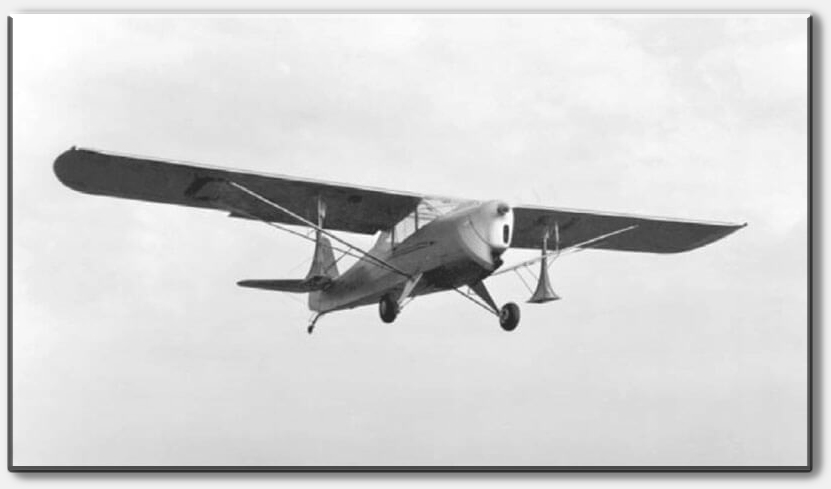
Auster with loudspeaker attachment
In May the last Auster V left the Squadron, with the farewell tribute,
‘They have proved an extremely reliable aircraft, having stood up to very heavy use without giving much trouble. We shall miss their reliability and nice handling qualities, but the reluctance of certain engines to start when hot will be remembered for a long time.’
In August, 1907 Flight reported from Sembawang that it had carried out the casualty evacuation of a Malay policeman who had been savaged by a tiger, while 1914 Flight announced that it had won nine and lost seven cricket matches. In September, the chief item of interest was the celebration which took place on Arnhem Day at 1911 Flight, at which the GOC, Major General Urquhart was the Guest of Honour. The function started with a ceremonial parade of the Flight, drawn up in review order with the aircraft and vehicles on parade. The GOC, flown in by Major Oldman, drew up as the Flight came to attention. He then inspected the parade, and talked personally with every man in the Flight about their jobs. After the parade, the General then gave a short but most interesting lecture to the Flight about the Battle of Arnhem, with the aid of two wall diagrams.
He then met the NCOs in the Sergeants’ Mess and talked with Staff Sergeants Gay, Gear and Sergeant Wastell, all of whom had been engaged in the battle. The OC of 1907 Flight, Captain Tom Lacey, took part in an interesting exercise in September. With the assistance of Lieutenant Commander Norman, the naval test pilot at Sembawang, he practised evasive action against a Hawker Sea Fury fighter. Diving turns to port or starboard proved effective from 800 feet, but ground level evasive tactics were not so successful. The wireless masts at Tebrau gave the best protection, and by agreement this was accepted as unfair to the Fury.
More challenges were to follow soon. On 03 November, Sergeant E.J. Webb of 1911 Flight, whose passenger was a police officer engaged in a visual reconnaissance of the area, had to make a forced landing in the deep jungle to the west of Gua Musang. The aircraft crashed due to engine failure, but fortunately the wireless remained intact and there was sufficient charge left in the damaged battery for an SOS to reach the Flight. This was made possible because Webb was carrying a wire aerial in the aircraft, which he erected as soon as he landed.
They were located after forty-eight hours, following a search by a large part of the Squadron. After receiving a supply drop, they ‘sailed happily down the Rivers Perola and Betis on a bamboo raft under Auster escort,’ back to the nearest police post. From there they walked twenty-five miles back to Gua Musang, and were then flown home, little the worse for their ordeal, bringing to an end a rescue and search operation which lasted for ‘four harassing and difficult days.’
Towards the end of the month the retiring Director of Operations, Sir Harold Briggs and his successor, Sir Rob Lockhart, were flown by pilots of 1911, 1914 Flights and SHQ, on a tour of the entire theatre. As the year came to a close, the Squadron could reflect on more records broken, with a total of 10,000 hours being flown – an average of 43.5 hours per pilot per month. Passenger flying took up over half of this, with visual reconnaissance flights for company and patrol commanders being regarded as particularly important.
The yearly summary also mentioned considerable success in finding CT camps and in directing air strikes against them. When the air effort was a large one, with possibly as many as twenty-five aircraft involved, the pilot who had located the camp, would direct the lead strike aircraft as a passenger in a Bristol Brigand B1 (the successor to the Beaufighter). Small and well-concealed targets, which were all but invisible to the faster types, could be marked by harking back to techniques used in Burma – firing a Very pistol from a low flying Auster and then guiding the Brigands or Vampires onto the mark by radio. It was in 1951 in which the highest number of casualties was suffered, 505 members of the Security Forces killed and 668 wounded, 660 civilians murdered and 1077 CTs killed, 121 captured and 201 surrendered
Korea
Though, strictly speaking, not part of 656’s story, events in Korea cannot be overlooked, not least because all reinforcements to the two flights supporting the 1st Commonwealth Division were provided from the Squadron, allowing many pilots a ‘change of air’ before returning to complete their tour in Malaya. Canadian and Australian pilots also served with the Flights.
The war had begun in June 1950 with a surprise attack from the Soviet-sponsored People’s Democratic Republic of North Korea on the American-backed Republic of Korea in the south. The United Nations responded and an international force was sent to Korea under US leadership. The Red Chinese Army entered combat in November 1950.
The following year would see much fierce fighting. No. 1903 Flight was sent from Hong Kong and 1913 Flight from the UK. 1903 Flight was conveyed to Iwakuni in Japan on board the aircraft carrier HMS Unicorn, in July 1951. Permission was sought to fly off but was not granted, so the aircraft were unloaded by lighter. Before long, the five Auster 6s were escorted across the Korea Strait from Ashiya to Pusan by a Short Sunderland flying boat of No 205 Squadron, thus the Flight had the distinction of being the first RAF unit to be based in Korea, commencing operational flying at the start of August.
The first flight over the front line was made by the OC, Major Ronnie Gower, taking the CRA, Brigadier W.G.H. Pike, DSO, up for a ‘general reconnaissance’ on 02 August. There was a gap of about 1000 yards between the opposing forces, bisected by the Imjin River. By the end of its first month the Flight had carried out thirty-four shoots with the artillery of 1st Commonwealth Division. A new airstrip was made by Canadian Sappers on paddy fields just south of the Imjin River and was dried out by the application of napalm to the surface, which was later acclaimed as the best in Korea.
The OC welcomed Captain Peter Downward, who was in command of 1913 Flight, on a preliminary visit in September. He was taken up on a typical two hour AOP sortie over enemy lines and, on landing, was interested to find that the loud bang which he had heard was indeed caused by an anti-aircraft shell, which had left a large hole in the starboard flap, a few inches from his head.
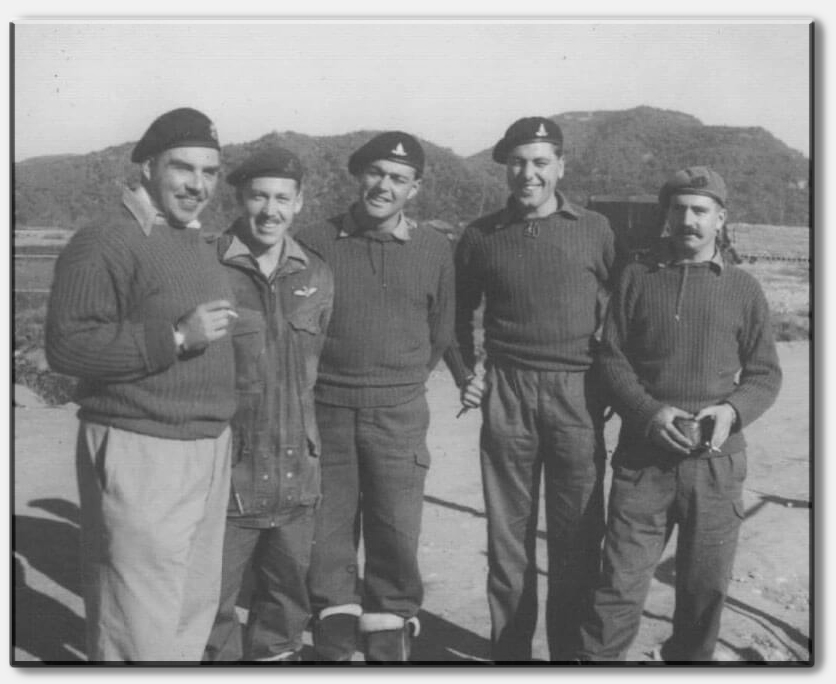
Maj ‘Warby’ Warburton, Capts P Tees RCA, J Crawshaw, G Joyce and B Forward RAA at Fort George
1913 Flight joined 1903 at Fort George early in November. The Flights’ primary tasks, working with Commonwealth and US forces, were observing enemy movements and gun positions, directing counter battery shoots and giving early warning of enemy attacks. Prior to offensives, battalion and company commanders were taken aloft to examine the areas over which they intended to advance.
It had been intended that, as a Light Liaison Flight staffed by six pilots from the Glider Pilot Regiment, 1913 Flight would confine its activities to air-taxi work. However, its OC made strong representations to his GOC, Major General C.A.J.H. ‘Jim’ Cassels, with the result that the two Flights shared much of the work, which allowed 1903 to concentrate on its primary duty of directing the fire of 14 Field Regiment RA, 16 New Zealand Field Regiment and 2 Royal Canadian Horse.
The UN forces had total air superiority over the battlefield, but there was still the ever present danger from antiaircraft fire, as Peter Downward had discovered. The Korean winter was harsh, but special clothing, engine heater tents and flameless heaters ensured that flying continued – though sleeping bags were not issued to all ranks until September 1952. Before the advent of winter clothing, pilots resorted to stuffing their flying kit with newspaper. Most sorties were flown above 5000 feet out of consideration of light flak. In contrast, during the hot, humid summer weather, the pilots often flew dressed in vests and PT shorts.
One of the pilots was Captain Gerry Joyce, who in later years would recall his time spent in the ‘Land of the Morning Calm.’ As the Flight’s role involved taking reconnaissance photos of enemy encampments and troop movements, they were required to know the terrain intimately. The Flight was based immediately behind the front line with its ‘office’ being an underground bunker. Nor were the living quarters any more attractive.
His description of the flying conditions is equally succinct,
‘Each pilot completed two sorties a day and round the clock sorties if attacks were mounted by either side. We flew from an airstrip that had been bulldozed along the River Imjin. I habitually flew low and fast, twisting and turning in and out of the mountainous terrain. The enemy tended to fire directly at the Auster and, having no knowledge of making allowance for deflection, the bullets usually passed harmlessly behind. For added security and just in case a stray bullet might find its mark, I always sat on my logbook!’
He also flew out to the aircraft carriers HMS Glory and HMS Ocean for special operations up the coast. Gerry flew hundreds of hours over enemy territory in the course of a continuous tour of duty lasting some eighteen months on operations.
No. 1913 Flight was also equipped with Auster 6s, to which was added a T7 in November 1952 and also, from January 1952, a US Army Cessna L-19A, reportedly as a result of the Corps Commander, Lieutenant General John W. ‘Iron Mike’ O’Danniel’s, ‘concern at the discomfort the GOC, Major General Cassels suffered when travelling about in an Auster.’ The GOC had an unfortunate upside-down landing in an Auster flown by his Canadian ADC.
Interestingly, in a letter written in 1977 to Brigadier Peter Mead, Colonel Bob Begbie, who was then a young captain flying Air OP sorties in Korea with the 3rd US Light Aviation Section, noted that the Flight had ‘inherited his plush, new L-19.’ Begbie not only flew the Bird Dog operationally, but also the Stinson L-5 Sentinel, Aeronca L-16 Grasshopper, Ryan L-17B Navion and North American T6F Texan; being awarded the US Air Medal for his efforts. In the 1960s he achieved further distinction when he became OC 656.
Downward was succeeded as OC 1913 Flight by Captain Peter Wilson in 1952, while in the same year Gower was followed by Major Jim Hailes. Peter Wilson’s memories of Fort George include the abundance of golden-plumed pheasants in the vicinity. Shotguns were borrowed from the Americans and the rations were duly supplemented.
Another unorthodox arrangement was made on 06 February 1952, when the death of King George VI and the succession of Queen Elizabeth II were announced. The Divisional Artillery fired a 101 gun salute – with a live shell every fifteen seconds into the Chinese lines, following the order, ‘The King is dead, long live the Queen. One hundred and one gun salute, begin!’ A certain degree of black humour was the rule, as is evident from the following entry in the Operational Record Book of 26 October 1952,
‘Captain H.B. Warburton, DFC, RA took a bath, a hazardous and unpleasant business at this time of year and Captain Tees RCHA washed what was left of his hair. Warby celebrated his 1903rd hour in the air before heading off to Malaya as OC 1907.”
Korea Awards and Casualties
During two years of operational service in Korea, Flight personnel were awarded one DSO, eleven DFCs, two BEMs, two American Air Medals and fourteen Mentions in Dispatches.
It was not without cost in human life; on 05 June 1952, Captain B.T. ‘Joe’ Luscombe of the Royal Australian Artillery was shot down by anti-aircraft fire. The rudder cable of his Auster 6 was severed, the aircraft stalled and he flew into a small cliff just near the landing strip as he tried to land.
Early in August, American backpack type parachutes were issued and a week afterwards Captain Joe Liston, of the Royal Canadian Artillery, was shot down while flying VF561, baled out and was taken prisoner.
Towards the end of that year, on 09 December, Gunner Alan ‘Nobby’ Bond died at the age of only twenty, when a store hut caught fire. On 12 May 1953, LAC K. ‘Tubby’ Goodfield, who was just nineteen, went up with Captain Ken Perkins on a regular sortie in an Auster 6, but on their way back hit a low slung cable and came down in the swollen Imjin River, the aircraft flipping over onto its back. Perkins managed to get clear but despite his best efforts, Goodfield became tangled up with some flotsam, was carried downstream and drowned.
Only five days later, Sergeant Cameron and Craftsman Duffy of 1913 Flight were carrying out a dawn recce sortie when the aircraft was damaged by a shell exploding just below, they both baled out and became prisoners of war.
Coronation Day, 02 June 1953, was also the day when the news of the conquest of Everest by Edmund Hilary and Sherpa Tenzing was announced. The OC, Major Wilfred Harris MC, was busy organizing the Flight’s celebrations and, having got them underway in the Officers’ Mess, jumped into a Jeep to drive round to the Sergeants’ Mess to do likewise. This entailed crossing the airstrip. It is not altogether clear what happened but it seems that two American fighter aircraft came in over the strip waggling their wings. Whether Harris thought this was some kind of acknowledgement of the celebrations going on will never be known. It appears now, that they were in fact trying to warn of the imminent attempt by another of their pilots to land a badly damaged Republic F-84 Thunderjet.
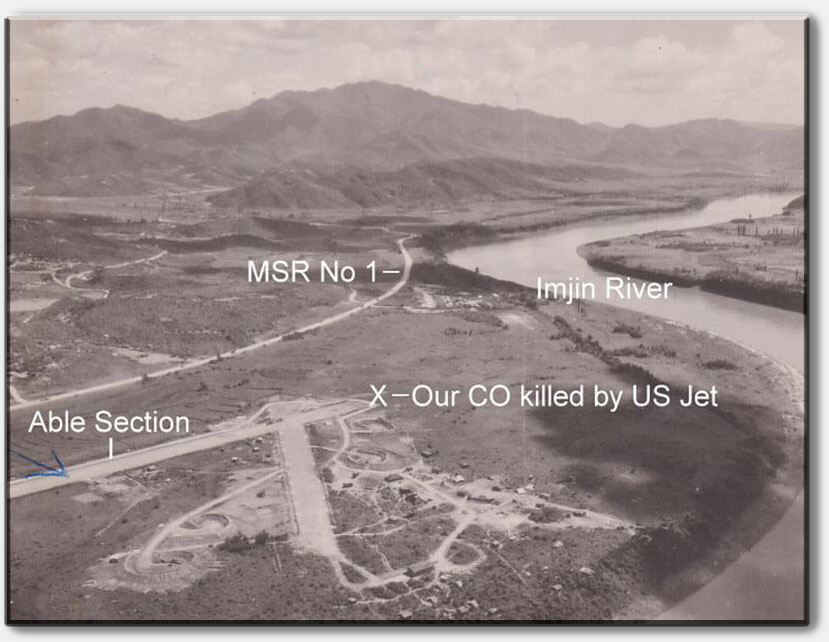
1903 and 1913 Flights were based at Fort George in Korea from the Autumn of 1951 onwards. This photo shows the Western side of the strip, home to 1903
Upon touching down, its undercarriage collapsed, the aircraft slewed and careered off the runway into the path of the Jeep. It was completely destroyed and Major Harris died instantly.
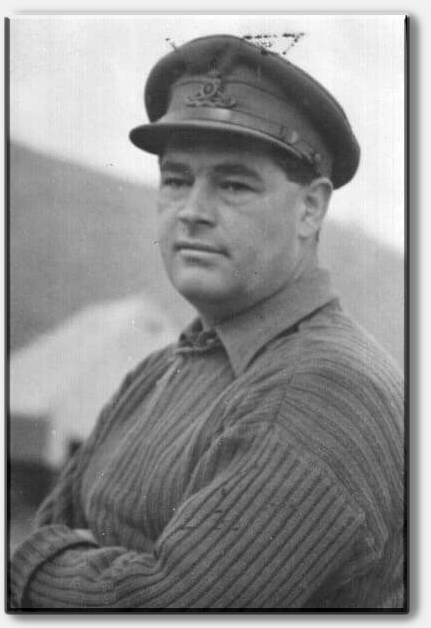
Maj W Harris MC, OC of 1903 Flight, who sadly was killed in an accident on the ground on June 2 1953, Coronation Day
Peter Wilson also had a dangerous encounter with an out of control aeroplane when a badly damaged T6 Texan attempted a forced landing at Fort George. The pilot’s vision was obscured by engine oil covering the canopy and he did not realize that he was in fact chasing Peter down the adjacent vehicle track as he bounced along the strip. The danger was not over even as it came to rest, as a malfunction caused its underwing rockets to fire. Peter fell and cartwheeled into the paddy, which was also a minefield. He was rescued by Ken Perkins and spent the next week in hospital with severe cuts and bruises.
He remains deeply proud of his service with the Flight and of its contribution to the war,
‘It was a small, very efficient unit which at any time only comprised about fifty servicemen who, despite horrendous weather conditions, lack of proper clothing, housing and heating, survived, and all aircraft were operational except when extreme weather prevented. The Flight flew some 3000 AOP sorties. Captain Derek Jarvis alone flew 639 operational hours in Korea, which included 306 operational sorties, 304 air shoots and 60 night landings.’
Armistice
An armistice was signed on 27 July 1953, and an uneasy peace has prevailed over the following half century and more.
The flights remained in Korea, however, and most of the flying for the next eighteen months or so in involved patrolling the Demilitarized Zone (DMZ), which entailed flying six hours per day in sorties of one or two hours in length, up and down the divisional boundaries at a height of above 5000 feet and 1000 yards back from the southern edge of the DMZ.
A considerable amount of time was also devoted to photographic sorties and to conducting practice artillery shoots. One activity which gave the pilots considerable pleasure was a fighter evasion exercise with the Gloster Meteor F.8s of No 77 Squadron RAAF, which showed that the Austers were ‘surprisingly capable, under most circumstances, of avoiding an attack by up to two jet fighters.’
Another unusual exercise was carried out by 1913 Flight on 18 March 1954, which involved US Special Forces parachuting from the Austers over the Han River, north of Seoul. Both 1903 and 1913 Flights returned to the UK early in 1955.
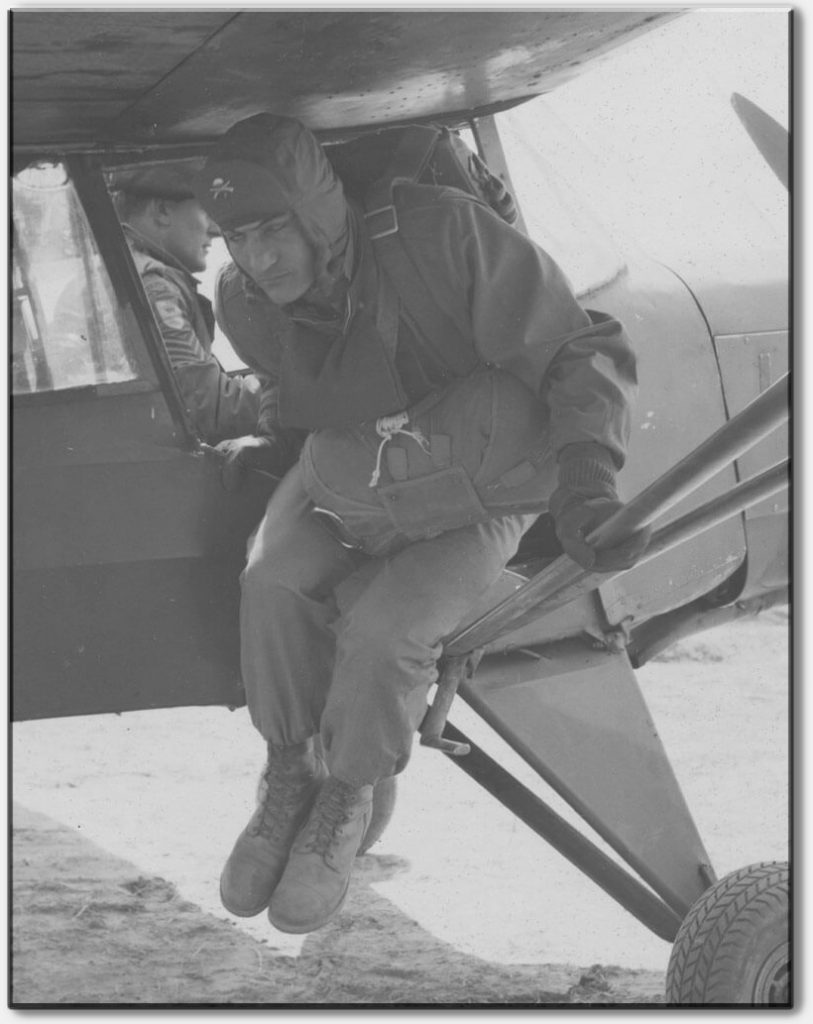
March 18 1954, a member of US Special Forces practices before his parachute drop from Auster VF516. The pilot is 1913 Flight’s ‘Red’ Meaton
Malaya Part II
Following a fact-finding visit by the new Conservative Secretary of State for the Colonies, Oliver Lyttelton, it was decided that the posts of High Commissioner and Director of Operations would be combined, and on 05 February 1952, this appointment was taken up by General Sir Gerald Templar. Given supreme and unified control, he would prove to be a dynamic leader, sweeping aside the complacency which still manifested itself in some parts of the administration. He was vested with wide powers with the aim of defeating the CTs utterly and gave assurances that Britain would not quit its responsibilities until Malaya was a stable self-governing nation.
One of the most significant improvements for 656 Squadron concerned communications. Several aircraft were fitted with VHF radio sets. These were deemed a great success, giving improved communication over a large area and also access to homing facilities, with good cover from Singapore to Taiping via Kuala Lumpur, and in the centre, cover from a relay station over a smaller area. Individual aircrew and Austers co-operated successfully with Bristol Brigands in target identification using VHF communications.
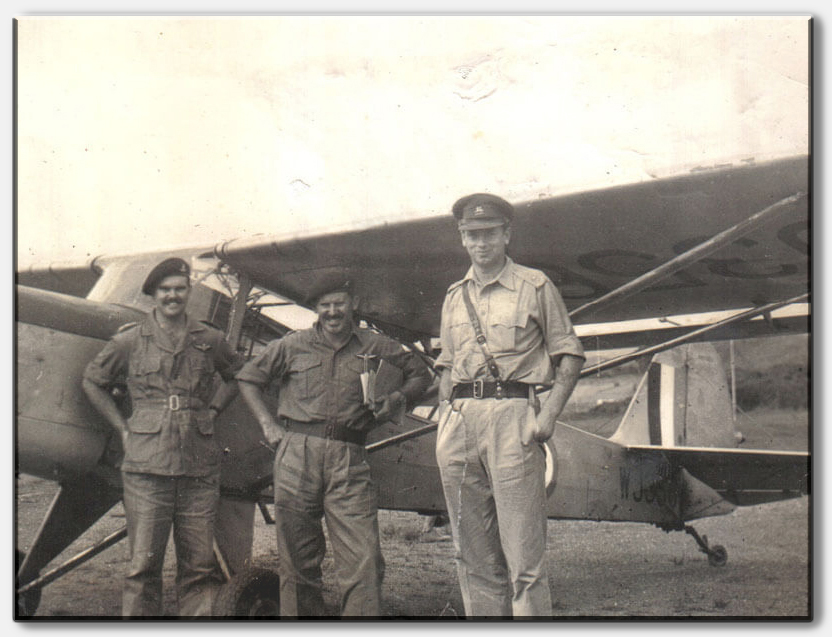
Captain Peter Short and Maj Banger Wheeler with an unknown officer in Malaya
Full authority was obtained ‘after a long hard battle’ for fitting the trailing aerial modification to all aircraft. This may well have been considered something of a mixed blessing for Captain Peter Wilson, who landed at Kuala Lumpur one day, only to be told he’d blacked out ‘the whole of KL’ by forgetting to wind in his aerial, which he had managed to drag through a power line. The Squadron suffered a fatality on 13 March, when Staff Sergeant Dennis Gay of 1911 Flight spun in on approach to Kulai Besar, about twenty miles from Johore Bahru, while flying Auster 6, VF576. The aircraft impacted in a rubber plantation, sadly Gay was killed and his passenger, Sergeant Hill, was injured. David Oldman had a fairly fortunate escape when testing out a new airstrip. He did a low-level run over the strip and when turning on completion of the run his propeller disintegrated. He had no option but to land straight ahead in a swamp. The aircraft came to rest upside down and he described himself later as, ‘a very muddy officer.’

Aircraft aften had to land on roads to refuel. In this case at Kluang Ngae on the Thai border
The three most experienced pilots were the OC, the indefatigable ‘Warby’, who had returned for another operational tour and Captain L.J. Wheeler, DFC, the OC of 1914 Flight. Warby had a lucky escape a little later in the year when his engine lost power and eventually failed some fifteen miles inland from the East Coast, giving him ‘an unpleasant ten minutes.’ He managed to maintain sufficient height to make a forced landing. It did not curb his enthusiasm, as he volunteered for a short spell in Korea, from whence he returned ‘having completed his third row of medal ribbons.’
Other postings to Korea during the year included Captain J.M.H. Hailes, who assumed command of 1903 Flight. A more serious accident was experienced by 1914 Flight’s Sergeant J Rolley in Auster 6 when, on 03 June, he became overdue on a reconnaissance flight with a police officer. He had taken off with an unserviceable wireless set so that no contact could be made with him throughout his sortie. A search was instituted and the position of the survivors was spotted. The ground forces who went in to meet them never actually found them, but they turned up on their own forty-eight hours later.
Sergeant Rolley was able to report that he had been ‘out climbed by a mountain’ after having flown up a valley in which he was unable to turn. David Oldman’s time as OC expired at the end of June, returning to the UK for ‘no doubt a life of ease if not glory, on the staff.’ He was replaced by the newly promoted Major Wheeler. Oldman was a real AOP veteran, having first learned to fly on No 3 Course with Denis Coyle at Larkhill in 1940.
It was reported that a safe and successful target marker had been produced to replace the faithful old Very cartridge, made from a No 8 Smoke Generator, ignited by a No 4 Pull Switch and a small piece of safety fuse, the whole being held together by a locally produced bracket. It produced smoke for three minutes and became known as the Hawkins Marker, as it was invented by a captain of that name. Its only limitation was that it had to be released at a height great enough for the device to ignite before it hit the ground. This proved to be between 300 to 500 feet.
A not so successful experiment was the ‘crop-spraying Agricultural Auster, VF560.’ The liquid used was diesoline. The aim was to spray and destroy vegetable crops grown by the CTs in small clearings of five to ten acres, normally surrounded by tall jungle. It was noted that, ‘mechanically, the machine has been made to work: that is to say, drops of water do come out of the spreader or boom. It also flies – just.’ The estimated flying height was not less than 250 feet above ground level. Most of these clearings were on very steep mountainsides, which must have served to concentrate the mind of a sprayequipped pilot.
The crop spraying machine was finally returned to 390 MU for reconversion. The trials proved that under ideal conditions the maximum liquid output was 42 gallons per acre which was too small a volume for the task. By the end of June the Squadron announced that it had achieved a grand total, since 1948, of 20,000 hours in 27,000 sorties, which represented,
‘Much hard, sometimes exciting, but all too often, monotonous routine flying on the part of the pilots, many sun-scorched hours of maintenance by the airmen and great numbers of miles, signals, and letters chalked up by the remainder.’
A signal of appreciation was received from the GOC,
‘The GOC Malaya wishes to congratulate No 656 AOP Squadron on having completed twenty thousand hours of flying. This is a considerable achievement and is even more impressive when considered with the number of sorties flown and the infinitesimal accident rate. The figures demonstrate the efficiency and keenness both of the pilots and the ground staff who carry out the maintenance. Please pass on my congratulations to all ranks on this first class record.’
It was felt that the Squadron Newsletter should add a few thoughts on those 20,000 hours, in the shape of a letter from ‘Banger’ [Major Wheeler] to ‘Dick’ [possibly Captain R.D. Wilkinson],
‘The flying roles have varied but slightly. In the early days, much emphasis was placed on air recces after incidents, searches for patrols out of contact and supply drops. With the overall change in the role of the security forces generally (The Briggs Plan), the emphasis now is upon visual recces for ground troop commanders and to locate food producing areas, photo recce, casualty evacuation in conjunction with the helicopters and, oddly enough, shooting the field battery.
Recently, 1914 Flight flew fifteen hours Air OP, Lieutenant Joe Sellers completing 10 shoots in a morning, an unusual number in Malaya. [As the 1950s wore on many thousands of rounds were fired as they were approaching their “fire-by” or expiry date and it seemed a shame to waste them by dumping them in the sea.] There is always an element of doubt about a CT camp. Not only are they difficult to find but having found them one has to convince the local units or formation that they are a worthwhile target. This reluctance may be forgiven when one remembers that, depending upon the position, it may well take anything up to a week for the troops to walk there. The simplest answer always is an airstrike, but some advantage of this is lost if no troops are immediately available to follow-up. One of the camps found by 1902 Flight was such a target. It was subsequently discovered that the camp was not only much larger than first thought, but that it was occupied by about sixty men at the time of the strike.
These roles of course are divorced from the communication work which in fact still makes up the greater part of the flying. Wearisome though this may be, it is undoubtedly worthwhile, as its saves not only time, but also allows manpower to be used for operational tasks rather than on road convoy duties. The development of airstrips has gone on throughout the whole three years. Quite apart from those on the West Coast which are now to be found in almost every town of any size, in North Johore and Pahang, Kampong Baapa, Kampong Aur, Gambir, Temerloh, Jerantut, Bentong and Raub have all been opened up. South Kelantan began to be opened up, but owing to lack of demands and shortage of bandits, is reverting again, except for Gua Musang which has been extended to Beaver specifications. Altogether there are now about eighty landing grounds in constant use.
The most important advantage the AOP 6 has over the Mk V is that we are able to carry a wireless set at all times and with the production of a trailing aerial the pilot is in constant touch on the Squadron Command Net. You will probably readily agree that this can be most comforting. It has also the added facilities of longer range, a selfstarter, better vision and so on. It is, however, unquestionably more troublesome technically and not nearly so efficient and reliable as the Mk V. The Gipsy VII engine is most unpopular.
During the Emergency almost every single VIP who resides in, or has visited Malaya, has been carried in an aircraft of the Squadron and also officers from the American and French Armies, the Military Attaché to Siam and US Military Attaché.’
In support of this, the example was cited of a DH Hornet F3 from No 33 Squadron which disappeared on a strike only 500 yards from 1911 Flight Airstrip at Seremban. The sudden break in radio contact made it almost certain that it had crashed near the target area. Despite the following factors, namely a helicopter was nearby and listening out when the crash occurred, two Austers and a Sunderland were airborne near the target area, they all failed to locate the crash. It was eventually found by ground troops, after which a few broken branches became apparent from the air.
To be fair, it was later recorded that by the time the Auster returned to Taiping it had flown 184 hours in a little over six weeks. Some thousands of square miles of the remoter regions of Malaya were covered during this period and much useful information was produced. In November, 1914 Flight, which was, of course, the link with the original 656 Squadron, completed 10,000 hours flying since the declaration of the Emergency. Two pilots in particular were mentioned, Captain Bruce Venour, who, in February 1950, became the first pilot serving in Malaya to complete 1000 hours and Lieutenant Joe Sellers, who in three years had flown more than 1400 hours in Malaya alone.
A new air route for communication was opened during December by Major Wheeler, who, ‘after much careful thought and preparation,’ took a policeman from Alor Star in Kedah, to Songkhla in Siam. It was decided that the operational emphasis had changed sufficiently to alter the designation of two flights, 1907 and 1911, from Air OP to Light Liaison and that of the unit as a whole to 656 AOP/LL Squadron.
At the start of the first Newsletter in 1953, the OC described the various types of duty that the Squadron was required to undertake,
‘Firstly, the square by square search by flights of their entire areas to provide such up to date information on terrorist activity as can be seen. These recces are done as and when possible, the aim being to cover the whole area about once a quarter. For specific large operations reconnaissance of a selected area is often made about a month in advance. Alternatively, we may be asked to find some particular piece of information, or to fly a battalion or company commander over his area for a general look/see.
It also includes flights for specialists like the Protectors of Aborigines, who can estimate the number of Sakai living in any particular valley from the amount of visible cultivation. Other important tasks include vectoring patrols into camps or clearings, looking for patrols out of wireless contact, selecting landing zones for casualty evacuations and a most important and popular task, the marking of occasional targets for air strikes.
The other familiar tasks, communications, Air OP, supply dropping, PR and leaflet dropping, continue in much the same proportion. Each flight now has a fairly comprehensive intelligence organization where all the information which they have collected is recorded.’
The leaflet dropping was part of a very significant psychological warfare operation, normally large transport or bomber aircraft were used, but the Austers came into their own when accurate drops of limited quantities of leaflets were needed, often when the requirement was to exploit rapidly a local success achieved by security forces on the ground. The OC continued with some remarks about target marking and how it had been improved and refined,
‘After some trials with an Avro Lincoln B1 heavy bomber squadron from Singapore it was eventually decided that a normal No 80 phosphorus grenade, operated by a static line and using bomb safety wire in lieu of the normal pin, was the best answer. The duration of smoke is short but the technique allows the bombers to attack one minute after the Auster has marked. To allow for errors in timing, for operations, the Hawkins and the 80 grenade have been combined. It is said that the use of this marker materially assists the accuracy of the Lincolns when bombing in formation.’
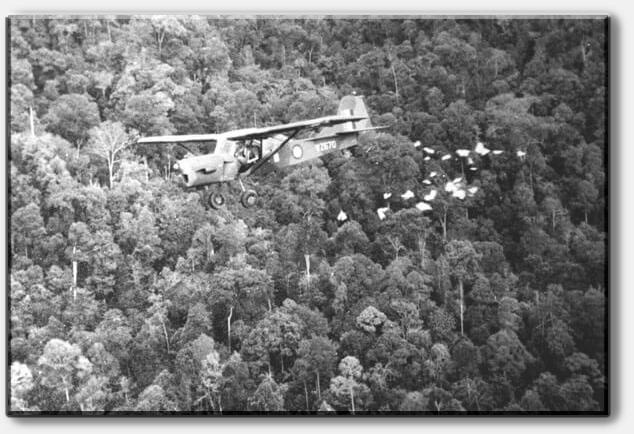
Auster 9 Dropping leaflets
The OC then moved on to a description of a contraption which had been designed to assist supply dropping,
‘1914 Flight has produced a small hook and spring device known as the Selrick Dropper (specifications by Captain Sellers, design and prototype by Corporal Rickards and execution by No 1 Station Workshops) which enables supply dropping to be done entirely by the pilot. Not only can this be done with much greater accuracy than before, but the absence of a dispatcher enables a much greater load to be carried. The articles to be dropped are suspended outside the aircraft, dropped, and the next lot hung outside, all by the pilot; 216lbs of rations i.e. forty-eight men for one day, have been carried and despatched by the pilot.’
Concluding the OC’s final Newsletter with some statistical gems,
‘During this quarter all our previous records were surpassed by a margin which one would have thought scarcely possible. The total flying for the quarter was 3989 hours of which 1574 were flown in March. 1902 Flight now holds the monthly record with no less than 483 hours and Captain F.C. Russell holding the individual monthly record with 103 hours. He was closely followed by Captain C.H.C. Pickthall of 1907 Flight, with 101 hours. After March it was suggested that 1902 Flight might find it simpler to record the hours spent on the ground.’
In August, the first large-scale spraying operation with S-55s (HAR 21s) took place in Johore. This was known as Cyclone, and 1902 Flight provided the up-to-date information on thirty clearings. In order to safeguard the spraying helicopters, all clearings were marked by Auster and strafed by Hornets before the S-55 arrived with the defoliant to begin its work, which would otherwise certainly have been vulnerable to ground fire. The majority of these operations took place between late 1953 and early 1954.
It was noted that the number of terrorist provoked incidents had dropped from a total of about 6000 in 1951, to some 1100 in 1953, and that the average monthly terrorist elimination rate for 1953 was 110 (including kills, captures and surrenders). It was thought that the decrease was due to the fact that a good deal of CT effort had been diverted from provoking incidents, to existing in the jungle. With the increase of food control and pressure by the Security Forces, CTs have had to retire into deep jungle areas and grow food in order to live. The Squadron flew a total of 16,665 hours during the year, including its 50,000th Firedog hour on 05 October,
‘And in case we are accused of hour bashing, it was not a case of looking for work, but turning down many of the less important demands. The importance of the Austers to Security Forces operating in the jungle has been realized to an increasing extent. Flight Commanders have worked hard to educate units in obtaining the best results from light aircraft and it is true to say that no military operation now takes place without the information and support of the Squadron.
The advent of helicopters in Malaya has transformed many operations which previously would have entailed hours of hacking through jungle. Troops are easily lifted in a matter of minutes to within striking distance of their objective. Much of our work consists of co-operating with the helicopters in both troop lifting and casualty evacuation.’
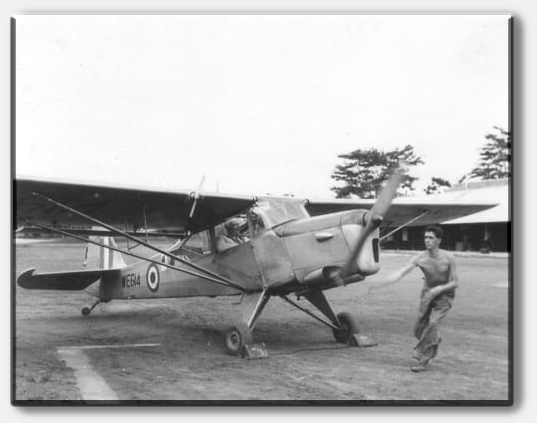
Starting an Auster by prop swinging at Noble Field Kuala Lumpa
In 1954 the aircraft establishment was raised by five, making a total of thirty-one Austers. After a certain amount of debate, the proposal of a fifth flight was turned down and it was agreed to absorb the extra aircraft into the existing flights, with the intention of positioning aircraft as follows; Taiping, Benta, Noble Field (Kuala Lumpur) eight each, Seremban and Sembawang six apiece. However, this was still an aspiration as the supply of new Austers was unable to fulfil the demand. The utilization rate was also increased to seventy hours per aircraft per month. Writing many years later, Colonel Michael Hickey described life at Benta,
‘All who served at Benta airstrip will remember it as long as they live. Hacked out of a rubber plantation during the Japanese occupation as an emergency landing ground, and guarded by a company of infantry (for it was in the heart of a “black” area), it boasted a few palm-thatched attap huts and a clutch of tents.
The aircraft lived in the open, exposed to the worst the Malayan climate could provide. Dense mists enshrouded the treetops and prohibited early morning flying. By 0900 the first Austers were about their business; by noon, the daily build-up of cumulonimbus thunderheads was looming in all directions; in the mid-afternoon, torrential rain, fierce electric storms, high winds and extreme turbulence made light-aircraft flying a hazardous pastime.’
An interesting operation was subsequently reported on in the Auster News,
‘It is worth placing on record the facts of a unique operation carried out in Malaya early in March by a destroyer and a military Auster. The destroyer was the 2600-ton HMS Defender, one of Britain’s most modern warships. Slowly sailing up the Johore River and avoiding the many sand-banks and reefs: the Defenderpassed through many miles of uncharted waters and finally arrived at a position from which she could bombard Communist guerrilla hideouts.
As the Defenderdropped anchor and opened fire with her six 4.5 inch guns, an Auster arrived overhead and proceeded to direct the fire by radio. Soon after the bombardment had finished Gurkha troops moved in on the shattered jungle hideouts and mopped up any survivors.’
Some technical advances were noted, firstly regarding target marking, ‘in fact, after years of experiment we think we have the answer.’ A number of aircraft were modified with the Light Series Bomb Carrier mounted on a metal frame under the fuselage. It was manually operated by means of a Bowden cable mounted to the right and just aft of the pilot’s seat. The actual marker was a Flare Reconnaissance No. 2 Mk 1, with a double parachute. Each weighed about 18lbs and a total of four were carried in the rack. Lincoln and Hornet crews were reported to be pleased with the volume and duration of smoke. The number of strike missions flown peaked in 1945, with a total of 426 during the year.
In June, General Sir Gerald Templer left Malaya and the functions of High Commissioner and Director of Operations were split. Sir Donald MacGillivray was appointed civil High Commissioner and Lieutenant General Sir Geoffrey Bourne, in his capacity as GOC Malaya (renamed Malaya Command), became Director of Operations. General Templer, General Bourne, and Air Vice-Marshal Sherger visited Noble Field in May. General Templer congratulated SHQ on its layout, although ‘nothing could persuade the distinguished visitors to enter the OC’s newly decorated and adorned office which had had a special sprucing up for the occasion.’
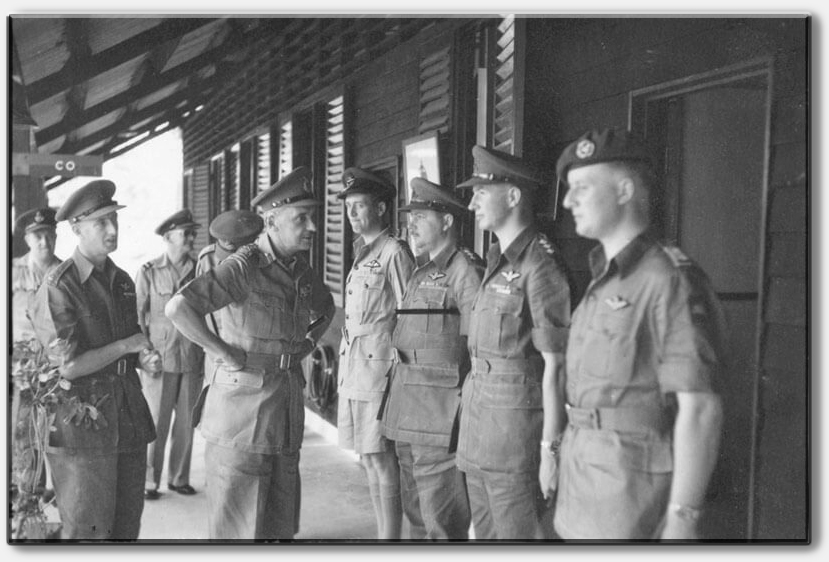
OC Maj Sandy Roberson, Gen Sir Gerald Templer, Flt Lt Niven, Capt Bath, Capt Ken Perkins
Sir Gerald talked with all the pilots and most of the soldiers and airmen; before leaving he said the Squadron was doing a first class job of work, its efforts being appreciated by everybody. By then the aircraft strength had reached its complement of thirty-one and not entirely tongue in cheek, the following comment was offered, but probably not directly to the VIP guests,
‘With a monthly task of over 2000 hours we wonder if this is not the largest and most flown Squadron in history and if the title of Wing (with appropriate promotions) would not be more fitting. The fact that the pilots fly between 75 and 100 hours a month and the aircraft, which when not actually flying, stand out in the open in a rigorous climate, achieve 100 hours per month, is a very great tribute to pilots, ground crew and aircraft alike.’
The threat of armed revolution is now broken
In July the Director of Operations was able to announce without fear of contradiction that, ‘the threat of armed revolution is now broken.’ These regular Newsletters are such a valuable source of contemporary information to the historian that it is of interest to include a few words from Major Robertson on the rationale behind their production,
‘It is perhaps necessary to restate the aim of this, and perhaps other, AOP newsletters. The original idea was to exchange news and views with other Squadrons and the Light Aircraft School at Middle Wallop. Due to popular demand however, the distribution list has assumed formidable proportions, but it must be stated that the quarterly Squadron newsletter in no way constitutes an official report of activities. We hope that facts are correctly presented and opinions are personal opinions of members of the Squadron. Should newsletters be bound by the rules relating to official documents much of their value would been lost.’
In the December Newsletter he provided this summary of the Squadron’s recent achievements,
‘From our point of view, 1954 was a year of greatly increased effort. The total number of Firedog hours flown to the end of December is now 77,591.55 and the number of sorties flown, 90,105. The value of Auster support has been recognized to an increasing extent and during the year 23,252 hours were flown. Put another way, this is equivalent to flying an aircraft eighty-three times around the world, or keeping five Austers airborne over the jungle every hour of every day of the year. Hours flown are, of course, only a means to an end and it is the finds which really matter. Our finds for 1954 are not published for security reasons, but in view of the present difficulty in finding CTs from the air, they are regarded as not unsatisfactory, and justify the hours spent on visual reconnaissance at between 1000 and 3000 feet with a pair of binoculars. The excellent serviceability of the Auster 6 and 7 is noteworthy – an average of 78 per cent having been attained. First and second line servicing personnel are to be congratulated on their very fine efforts.’
The first item of note in 1955 was the arrival of the Canberra B6 jet bombers of No 101 Squadron, which was soon working on strike missions with 1902 Flight. The down draught season claimed a victim in February. Captain L.P. ‘Mick’ Griffiths of 1914 Flight, was attempting to clear a ridge while engaged on a visual reconnaissance in the Kuala Klawang area. Too late, he realized that he was failing to climb and while turning away crashed into primary jungle. The pilot walked out on to a main road where he was picked up by a foot patrol. Then a couple of weeks later, Captain A.B.J. Forman of 1911 Flight, suddenly found his aeroplane had no propeller, five minutes after takeoff from Sembawang and at a height of 900 feet over the Naval Base. Despite the rude shock of this discovery, he put down, a truly miraculous landing in the ammunition storage area, to be precise, on top of a magazine containing 500 depth charges! Crankshaft failure was the cause of the incident.
The arrival of the Auster AOP 9 had been keenly anticipated. The last operational Auster version was considerably redesigned, with a 180 hp Bombardier engine, a full instrument panel, foot brakes and a new undercarriage, fin and rudder. The seating arrangement provided for the pilot was also a considerable boon, being upholstered in comfortable leather rather than the Mk 6’s ‘thin horsehair-filled biscuit’, which according to one pilot was the origin of the saying, ‘orficers ‘as ‘emorroids, sergeant pilots ‘as piles.’ The prototype had made its first flight from Rearsby in Leicestershire, in March 1954. In July 1955, the first production batch was delivered, accompanied by Les Leetham the Auster Company’s ‘test pilot, technical rep and general dogsbody,’ whose job was to iron out any snags that might arise. He noted that there was some urgency behind his task,
‘The Mk 6s and 7s had begun to shed their propeller hubs and as Army pilots were over hostile jungle territory and not Rearsby’s green fields, so prop hub doubts were not good news.’
The first Auster 9 to take to the air in Malaya was WZ670 on 14 July. It soon started to exhibit mechanical problems and having attended to these, Leetham was able to begin converting Squadron pilots, with Major Robertson as his first pupil. He was invited to visit some of the jungle airstrips to gain first-hand experience of what the pilots had to contend with on a daily basis,
‘Perhaps it was in return for my initiation routine that I was taken to some of their “pet” strips – the hairy ones – some literally hacked out of the surrounding jungle with the felled giant trees being used as the foundation for the 400 by 30 yard runway, with a surface of the all-pervading laterite – the local red, shale type deposits with the consistency of crushed brick. With some, I was told that if you could see the strip during the approach you were too high. On one, it was advisable to land uphill and take-off downhill, regardless of wind, and it wasn’t unusual to see directions in the Flight’s strip manual (essential reading) that certain locations in valley bottoms had offshoot clefts in the valley sides that had to be avoided after take-off, as they quickly became blind alleys, ending abruptly before the aircraft had time to gain height and were too narrow to allow a turn. I wondered how they found out in the first place. After seeing the terrain and the strips, remembering the storms and the down draught season when aircraft could be literally pushed below the tree tops, dodgy engines etc. you could only admire and marvel at the casual professionalism, courage and skill of the Air OP pilots.’
The Squadron Newsletter also had a few comments to make,
‘Originally scheduled to arrive in March, they in fact arrived in September. It was also found, that due to possible vaporization in the fuel system, they could not be flown if the ground temperature exceeded 86oF. The first four were therefore based at Noble Field and a comprehensive conversion training programme carried out during the early mornings and evenings for all pilots in the Squadron. This was run by acting Squadron Captain, Captain B.A. Allum, with the considerable assistance of Mr L.A. Leetham of Austers and Flight Sergeant C. Childs, who worked long hours and were handicapped by shortage of spares, ground equipment and publications.’
The opportunity was taken to pay tribute to the retiring types,
‘Introduced into the Squadron in July 1950, Mk 6s and 7s have flown 85,372 hours in support of Emergency operations. The aircraft has been made to do a variety of tasks for which it was never designed, and although its performance and handling characteristics have caused many rude comments among pilots, its serviceability record has been excellent. From June 1954 to June 1955, an average of 79 per cent has been achieved. The oldest aircraft in the Squadron, VF626, was recently pronounced a write-off after flying some 3400 hours, using up eight new engines and ten propellers in the process.’
Elected Federal Government took office, 1955
Two events of great political importance for the future of Malaya occurred during the summer of 1955. The first elected Federal Government took up office, and after seven years of fighting, an amnesty offer was made to the MCP. Terrorist activity slackened off, although incidents still occurred, mainly in Johore. The burning of twenty-eight estate lorries proved that the communists had by no means thrown in the sponge.
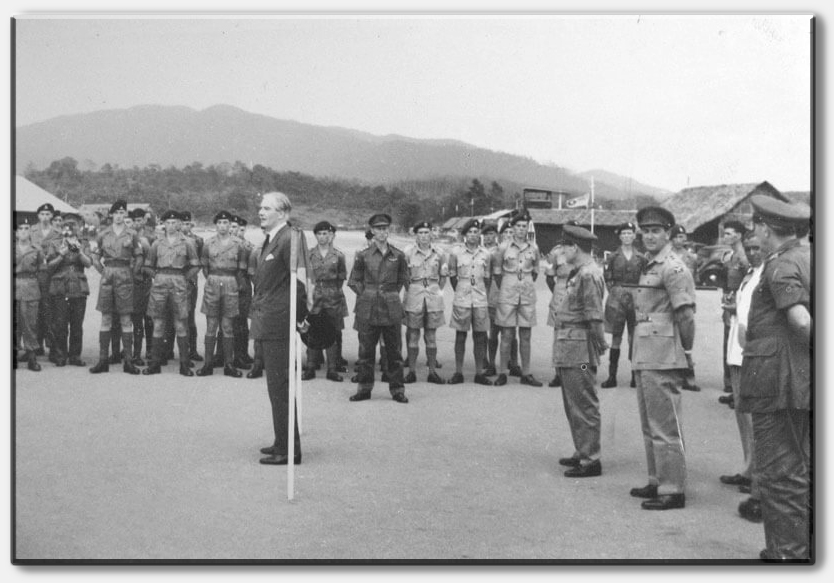
Anthony Eden addresses 1914 Flight at Paroi, during his second visit to them, in 1955
Amnesty day was also the tenth anniversary of the Squadron’s landing in Malaya. To mark the occasion, all flights held parties, including a very successful one in SHQ. The amnesty was not a success and the anti-terrorist war would continue into 1956 with the Malayan Government, headed by Tunku Abdul Rahman.
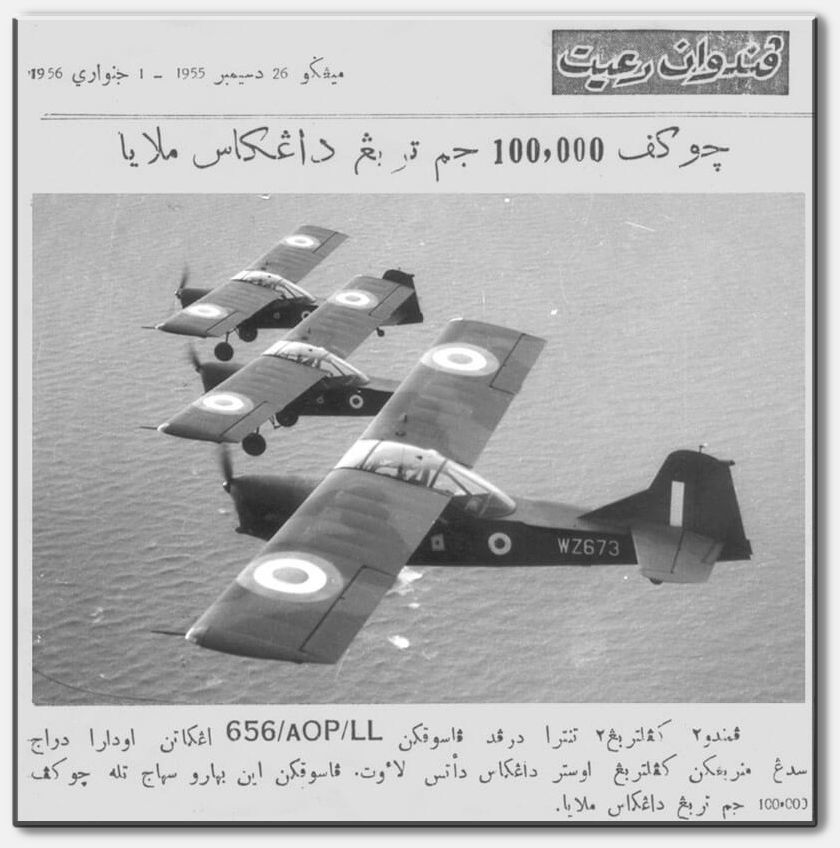
The Straits Times celebrates the Squadron’s 100,000 operational flying hours in Malaya
Another milestone passed by the Squadron was the completion of its 100,000 flying hour in Malaya, which the OC calculated was being nearly the same as flying one Auster around the world 332 times.
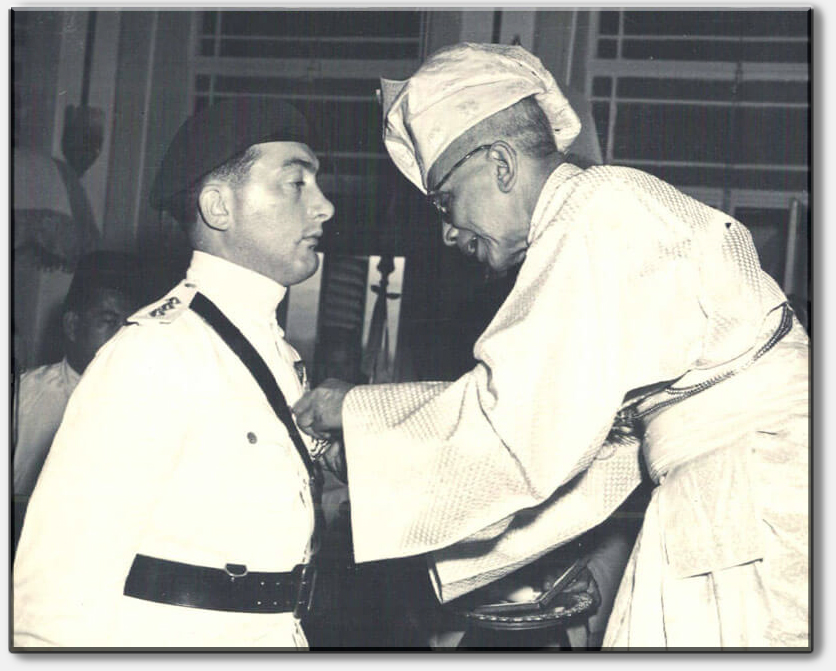
Jan 15 1956 Acting Capt Mike Hickey of 656 Squadron was presented with the DCM (Perak) medal by the Sultan of Perak
A new OC arrived at the end of January in the shape of a very familiar figure, Major Wheeler returning for a second tour in command.
By the end of March 1956 the Squadron was all but completely re-equipped with the Auster 9. It was generally agreed that it was a great improvement on the old Mk 6, despite the fact that during the first nine months of its service, more than fifty major defects due to faulty design or bad workmanship were discovered and rectified.
The year 1957 would be a momentous one, not only for Malaya, but also for Army Aviation. For 656 Squadron, in the first instance, it would be business as usual. Major Wheeler stood down as OC in June, but ‘soldiered on’ as 2i/c to the new CO, Lieutenant Colonel Brian Storey. He arrived just in time to receive the full brunt of the administrative work entailed in the changeover from RAF to Army Air Corps. RAF personnel were all slowly with drawn over a period of several months and replaced by the newly trained members of REME and a few ordinary airmen were replaced by soldiers.
The Squadron was re-titled 656 Light Aircraft Squadron Army Air Corps, with four flights – 2 Recce, 7 Recce, 11 Liaison and 14 Liaison and for the first time a Light Aircraft Squad ron Workshops REME. Dispersal was still the order of the day and small formation parades were held at Kuala Lumpur, Ipoh, Seremban, Taiping and Sembawang on 01 September.
The Squadron (and 1914 Flight) had been part of the RAF for fourteen years and nine months, of which, just one year and eight months had been spent in the UK. The day before Malaya had gained full independence – Merdeka – and from that time onwards, the maintenance of law and order would be the exclusive responsibility of the Governments of Malaya and Singapore, who naturally requested the continued assistance of the UK and other Commonwealth for the duration of the Emergency. The changeover caused the Squadron no loss of operational efficiency and indeed in October 1958, a fifth flight, 16 Recce, was added and stationed at Kuala Lumpur. Visitors to the Squadron in this period included the Duke and Duchess of Gloucester and also the Director of Operations, Lieutenant General Sir James Cassels.
Noble Field, Kuala Lumpur, Flying Display, 1959″
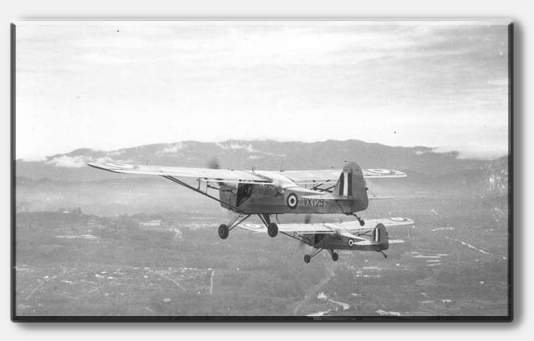
The Squadron practices formation flying above Kuala Lumpur
The undoubted highlight of the following year took place on 28 February 1959, when the Squadron gave a flying demonstration before a number of distinguished spectators at Noble Field, Kuala Lumpur, to mark the achievement of 150,000 operational flying hours.
This demonstration, followed by the presentation parade, was the culmination of the Squadron’s flying effort over the previous ten years. It opened with a formation flypast of eight aircraft in two boxes of four, line astern. This was followed by a message drop into a Land Rover, a ‘high-speed’ fly-past by a single aircraft, message pick up, supply drop by parachute and also by free drop, a target marking demo, a shoot (in conjunction with 1 Federation Battery) and finally, three aircraft of 14 Flight performing the ‘Prince of Wales’ Feathers.’
Immediately afterwards, the Squadron formed up on parade in a hollow square for the presentation of a ceremonial Kris by Lieutenant General F.H. Brooke, CB, CBE, DSO, C-in-C Federation Armed Forces and Director of Operations, on behalf of the Malayan Government. Major General J.A.R. Robertson, CB, CBE, DSO, GOC 17 Gurkha Division, then presented a ceremonial Kukri on behalf of 17 Gurkha Division. Lieutenant Colonel Storey, M.C., then replied for the Squadron. As soon as the presentations were made a photograph of the Squadron was taken, and the officers and their distinguished guests then left for the Officers’ Mess for the official luncheon. In the evening the officers entertained the sergeants in the Officers’ Mess, followed by a Sergeants’ Mess Ball: still later, the officers retired to the Selangor Club for a very late dinner. The Squadron then had a two-day standdown and individual flights held their own private celebrations. The speeches made at the presentation ceremony were as follows, firstly Lieutenant General Brooke,
‘Your Excellency, Ladies and Gentlemen, the acting Prime Minister and Minister of Defence of the Federation had very much hoped to be here today himself, to attend this very creditable and in fact more than that, unique celebration of your Squadron. Unfortunately, doing two jobs, he is a very busy man and just could not make it at the last moment. He has asked me to deputize for him, a duty which I have undertaken with the greatest pleasure.
The Minister has asked me to say these things. First of all, to congratulate you on this wonderful achievement, 150,000 flying hours; this is unique and the first time it has ever happened. Secondly to thank you all most sincerely for all the work you have done on behalf of the government and the people of the Federation in the last ten to twelve years. And thirdly to wish you all the very best of good luck and good fortune in the future. If I may add a personal note, I would like to thank the Squadron a great deal for all they have done for the Federation Army. I am sure I may speak for all the security forces of the Federation, including the Royal Federation Malay Police, and many government departments, whom you have helped by reconnaissance and in other ways.
I would like to make it even more personal and thank the Squadron very much for the wonderful service they have given in the six years-over six years-in which I have been pretty closely associated with the Squadron. Every demand on the Squadron that I know of has been met not only without delay, but with the greatest efficiency and the greatest cheerfulness. I myself have been carried all over the Federation and I count myself one of the more experienced Auster passengers in the business.
So thank you very much indeed, congratulations on your achievement and best wishes for the future. I therefore now take great pleasure in presenting to Colonel Storey on behalf of the government and people, armed forces and security forces of the Federation, this Kris.’
He was followed by Major General Robertson,
‘Your Excellency, Ladies and Gentlemen, Officers and Men of the Squadron, there is little that I can add to what General Brooke has already said; except to congratulate you on a magnificent record of which we in 17 Division and the Commonwealth Brigade are very, very proud. I would like to give now a Kukri on behalf of the Officers and Men in token of our very high regard for the work of the Squadron and wishing you the very, very best, in every way for the future.’
150,000 Flight Hours – an unbeatable record
The Sunday Times journalist, Harry Miller, wrote that 150,000 hours was equivalent to seventeen years of non-stop flying by a single Auster, or 498 times around the world. The Squadron also flew over 40,000 additional hours on training, air testing, demonstrations, etc., of a non-operational nature:
Communist Terrorist Camps found – Over 1,750
Supplies Dropped – 400 Tons
Aerial Observation for Artillery Fire – 3,500 Targets
Air Strikes Marked for Bombers – 4,000 Targets
Leaflets Dropped – 150,000,000
Passengers Carried – 50,000
Brigadier Peter Mead, who had flown very briefly with 1587 Flight in 1944 and would become Brigadier Army Aviation in 1961, wrote,
‘656 Squadron was in Malaya, where the war against the communists was in its eleventh year. Their reconnaissance was widely described as the greatest single factor against the terrorists, and one can say with confidence that in this theatre, Army Aviation had completely sold itself to the Army.’
A further visit was made to Borneo, for a month in the late summer of 1959, by 11 Flight. To ‘cover the North territory well; carry out several “casevacs,” help to round up pirates and guide home some of our own lost patrols.’
Advance notice was given of a remarkable plan being concocted by Captain Mike Somerton-Rayner, the OC of 2 Flight. In October, he had bought an Auster from the Kuala Lumpur Flying Club. It was registered 9M-ALB and had previously been VR-RBM with the club and VR-SCJ in Singapore, where it had been purchased by the Director of Civil Aviation in 1947. However, before that it had been AOP III MT438 and had served with the Squadron in Burma. Somerton-Rayner had decided that it would be much more fun to fly home at the end of his tour, rather than go by ship. The final Newsletter for the 1950s concluded with the following anecdote,
‘Recently a conversation was overheard at a ground OP during a recent Air OP shoot which may give old and new pilots food for thought: An AOP Officer, “Do you still post air sentries during shooting to safeguard passing aeroplanes?” Battery Commander, “Oh, yes – but of course there is no closed season for Austers, we consider them fair game!’
Largely due to the excellent liaison that existed between 11 Flight in Singapore and the Royal Navy, it was possible to carry out some deck landings on HMS Albionin the South Asian Sea off the coast of Johore in May. Intensive training in true naval style in the form of a cocktail party the previous night was a prelude to an enjoyable day’s flying. After making the first landing the OC watched from the compass platform while the QFI, Captain F. Legg, took Lieutenant Commander Flying, ‘with a martyred look’, to see how landing the Auster compared with his jet aircraft.
Each landing was witnessed by astonished groups on each side of the flight deck as a host of cameras filmed each effort, including those of Captain J. Bedford-Davies, Captain D.T. Cholerton and Sergeant G.T. Ryan. As the ship was steaming at nearly 30 knots into a thirty knot wind it was difficult for the Austers, ‘with a top speed of 80 knots downhill’ to catch up. Captain Keith Bush believed it was the only time he experienced vertical take-offs and landings.
A total of ten Austers landed on during the day and each pilot was later sent a certificate from Commander Joe Honywill stating that he had completed his deck landings on the carrier and continued:
‘Therefore let it be known that he has joined those beings known as Amphibians, and is now subject to Neptunus Rex, Lord of the Deeps, King of all funny creatures, sea monsters and sailors. This being so, he is wished the best of Luck.’
The Malayan Emergency somewhat petered out rather than ending in any dramatic fashion and was declared to be over, with the lifting of the Emergency regulations on 31 July. At the end of twelve years of sometimes bitter hostilities, over 7000 CTs had been killed and 4000 had surrendered or been captured.
On the other side of the balance sheet were the 2000 civilians who had lost their lives, as well as over 1000 Malay Police and 500 British, Malayan, Gurkha, Australian, New Zealand, Fijian and East African servicemen. The advance of Communism in South-East Asia had been halted, but at a considerable price in lives and money.
The Squadron took part in the End of Emergency parade in Kuala Lumpur, providing sixteen Austers in four boxes of four flying in close formation. It had flown 171,241 hours and carried out 181,236 sorties. Adding together India, Burma, Java, Sumatra and Malaya, the totals were 179,259.30 and 189,748 respectively.
The Squadron further reported that over those twelve years it had uncovered 2140 CT camps, dropped 6675 tons of supplies and no less than 232 million leaflets. It was time to resume peacetime soldiering and flying – for now. It was noted that the deployment of the Squadron remained unchanged: 2 Recce Flight at Ipoh and 7 Recce Flight at Taiping, both in North Malaya, SHQ and 16 Recce F1ight at Kuala Lumpur in Central Malaya, with 14 Liaison Flight at Seremban in South Malaya and 11 Liaison Flight at Singapore.
The tempo changed from operations to thoughts on retraining and the allied problems created by a new challenge for the Squadron – airportability. During trials carried out, one factor was foremost in mind, that of the extreme weight and bad design of so much of the equipment. ‘Outward Bound’ activity had its enthusiasts and an energetic club was formed. Its first major project was to climb the highest peak in Malaya, Gunong Tahan, a 7200 feet mountain in North Pahang in the middle of dense jungle. The trip lasted fourteen days and was led by the Adjutant, Captain R. Horne.
In September, Captain John Bedford-Davies set out with his pilots of 14 Flight for a trip to Bangkok. The CO noted,
‘It is not clear what training value this flight had, but from an almost closed shop attitude on the details, Bangkok must have produced some excellent training.’
Bedford-Davies also had a penchant for formation flying, and the Flight performed at various ceremonies, such as the Sultan’s Birthday Parade. On 04 September, Captain J.H.C. Roberts of 7 Flight was flying a visual reconnaissance in South Thailand when due to engine trouble he had to make a forced landing. The only available strip was a short stretch of laterite road on the edge of some paddy fields. The landing was successful with no damage to the aircraft. The recovery operation was carried out by a team from the Aircraft Workshop, supported by Sycamores of No 110 Squadron.
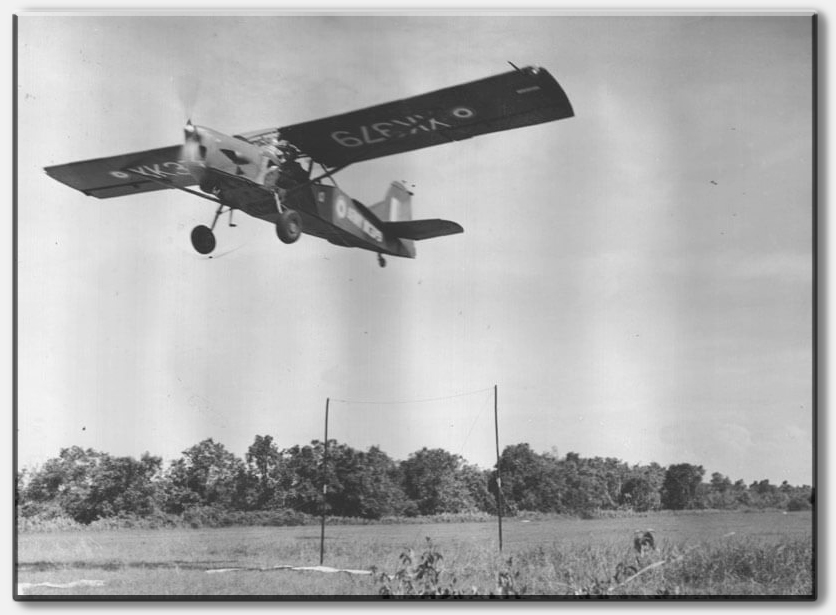
The old skill of airborne message pickup still being practiced by the Squadron in Malaya in 1960
Then on 01 October, Mike Somerton-Rayner and his wife, departed in their Auster, now rechristened ‘The Yellow Peril’. The aircraft had been modified to take a 25 gallon fuselage tank and was also equipped with a Plessey radio and a full blind flying panel. On take-off they were escorted by three of the Squadron’s Auster 9s and given a rousing send off. The journey home took six weeks, with thirtynine stops in sixteen countries on the way. As a further example of the desire to return to some sort of civilized normality some fine silverware was bought for use at Mess Formal Dinners,
‘It has long been the desire of the Squadron to possess a silver centrepiece of some distinction and value. To this end a fund has been subscribed to by Squadron officers for the past years. The fund, growing slowly, received a most magnificent gift from the Auster Company and associated manufacturers of the Auster 9. This gift made possible the purchase of a centrepiece. The inscription reads, “To commemorate the completion on 28th February, 1959, of 150,000 operational hours by 656 Light Aircraft Squadron in support of the Emergency in Malaya.”
